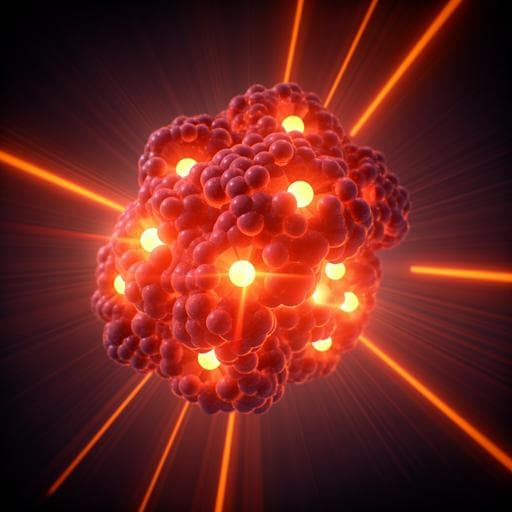
Physics
Aggregation Induced Emission Behavior in Oleylamine Acetone System and its Application to Get Improved Photocurrent from In₂S₃ Quantum Dots
S. Ramya, D. Nataraj, et al.
Discover the groundbreaking research by Subramaniam Ramya and colleagues on the intriguing aggregation-induced emission in an oleylamine-acetone system. This study not only unveils the formation of flower-like aggregates but also shows how they enhance the photocurrent of In₂S₃ quantum dots, achieving significant advancements in charge transport in photoconductor devices.
~3 min • Beginner • English
Introduction
The study investigates hydrogen-bond-driven molecular aggregation in an Oleylamine–Acetone system and its impact on photophysics and device performance. Building on Kasha’s framework of H- and J-aggregates and literature on hydrogen-bond-stabilized self-assembly, the authors hypothesize that aging-assisted NH⋯O=C hydrogen bonding between Oleylamine (primary amine) and Acetone (carbonyl) induces nanoscale molecular clusters that can self-assemble into larger aggregates with red-shifted emission due to exciton delocalization. The work aims to elucidate the conditions and mechanisms leading to hydrogen-bonded clusters versus imine formation via condensation, to demonstrate reversible aggregation/disaggregation with tunable photoluminescence, and to apply this process in In₂S₃ quantum dots (QDs) to improve photocurrent by mitigating surfactant-induced charge transport barriers.
Literature Review
Background covers molecular aggregates (H- and J-aggregates) and how dipole alignment leads to spectral shifts and exciton transport. Prior studies emphasize the role of noncovalent interactions (π–π stacking, halogen and hydrogen bonding) in ordering and semiconducting behavior, with examples including DNA, indigo, and quinacridone where NH⋯O=C hydrogen bonding enhances delocalization and mobility, often causing bathochromic shifts from solution to solid. Oleylamine is a widely used surfactant/capping ligand in colloidal nanocrystal synthesis, known to passivate surfaces but hinder charge hopping in devices. Literature on aggregation-induced emission (AIE), aggregation-caused quenching (ACQ), and aggregation-induced red-shifted emission (AIRSE) informs the expected photophysical transitions upon aggregation. The authors position their study as the first to demonstrate room-temperature, aging-assisted NH⋯O=C hydrogen bonding between Oleylamine and Acetone forming nanoscale clusters and flower-like aggregates, along with concurrent interfacial condensation to imines under certain mixing ratios.
Methodology
Chemicals: Oleylamine (≥98%, Aldrich) and Acetone (99%, Loba).
Oleylamine–Acetone preparation: Two regimes were studied. Immiscible system (low Acetone): 5 mL Oleylamine + 2 mL Acetone, stored in centrifuge tubes; initially transparent, becoming whitish after 10 min and separating into two layers over 4 weeks (upper yellowish, lower colorless). Under UV, upper emitted yellow, lower blue. Miscible system (high Acetone): 5 mL Oleylamine + 10 mL Acetone; color evolved from pale yellow to dark red over one month. Systematic solute:solvent ratios explored: 5 mL Oleylamine with 0.5–10 mL Acetone. A critical threshold of ~7 mL Acetone per 5 mL Oleylamine yielded fully red, miscible aged solutions; below this, phase separation occurred with distinct spectral signatures and evidence of interfacial reactions.
Dilution experiments: Aged red solutions were diluted by adding fixed 5 mL Acetone to varying aliquots (20, 100, 200, 500 µL) of the aged solution to study reversible spectral shifts and aggregation state changes.
In₂S₃ QD synthesis: Hot injection method. 0.001 mol InCl₃ dissolved in 1-dodecanethiol and stirred under Ar at 110 °C for 30 min. Elemental sulfur dissolved in Oleylamine, stirred under vacuum at 90 °C for 30 min. Sulfur solution injected into InCl₃ solution, mixed under Ar for 20 min to grow QDs. Purification via hexane/methanol (equimolar) antisolvent centrifugation at 5000 rpm for 30 min. Oleylamine and 1-dodecanethiol-capped blue-emitting In₂S₃ QDs were then dissolved in Acetone and aged for 1 month.
Characterization: Optical absorption and photoluminescence (PL) spectra recorded before and after aging; dilution series measured. High-resolution transmission electron microscopy (HRTEM) to visualize nanoscale clusters and self-assembled aggregates and to assess QD size (as-prepared ~3 nm; aged ~19 nm). Fourier-transform infrared spectroscopy (FTIR) to monitor vibrational shifts indicating hydrogen bonding (C=O shift) and imine formation (C=N). Raman spectroscopy to assess mode broadening associated with clustering. X-ray diffraction (XRD) thin films on borosilicate glass to check crystallinity (broad peak near 22° indicates amorphous nature). Time-correlated single photon counting (TCSPC) for excited-state lifetimes. Theoretical calculations: Quantum chemical analysis at sB3LYP/6-311G(d,p) level with BSSE corrections to compute interaction energies for complexes (Ace_Ace, OLA_OLA, OLA1_Ace, OLA2_Ace, OLA12_Ace), optimized geometries, HOMO-LUMO distributions, and solvatochromism simulations (Oleylamine in gas vs Acetone).
Device fabrication and testing: Photoconductor structure FTO/TiO₂/active layer/MoO₃/Al. Active layer variants: (i) Oleylamine–Acetone at time of mixing, (ii) aged molecular aggregates (undiluted and diluted), and (iii) aged In₂S₃ QD embedded in Oleylamine–Acetone aggregates. Photocurrent measured under a solar simulator with ON/OFF cycles at various biases; I–V measured in dark and under illumination.
Key Findings
- Aging induced strong red-shifts: Oleylamine–Acetone mixture changed absorption maximum from 350 nm (initial) to 585 nm (after ~30 days) and PL peak from 410 nm to 640 nm, with PL quenching upon aggregation.
- Reversible spectral tuning by dilution: Diluting the aged red solution produced controlled blue shifts in PL (e.g., 500 µL in 5 mL Acetone: PL ~555 nm; 200 µL: ~537 nm; 100 µL: ~494 nm; 20 µL: ~444 nm), indicating reversible aggregate disassembly into nanoscale clusters.
- Morphology: HRTEM revealed ~3 nm nanoscale clusters at high dilution (20 µL) and flower-like self-assembled aggregates with stacked nanoparticle motifs at higher concentrations (100–200 µL), with lateral extents ~180–390 nm and widths ~18–36 nm. Aggregation is rapid once clusters exist; initial cluster formation requires aging.
- FTIR evidence for hydrogen bonding: C=O stretching red-shifted from 1712 cm⁻¹ (Acetone) to 1706 cm⁻¹ in aged Oleylamine–Acetone, consistent with NH⋯O=C hydrogen bonding. In phase-separated (immiscible) systems, bottom layer showed water/Acetone hydrogen-bond signatures (C=O at 1694 cm⁻¹), while top layer exhibited both imine (C=N at 1662 cm⁻¹) and hydrogen-bonded C=O (~1710 cm⁻¹), evidencing concurrent condensation to imines and hydrogen-bonded clusters depending on conditions.
- Raman and XRD: Aged samples showed broad Raman bands, attributed to dense vibrational levels in clusters/aggregates; XRD displayed a broad peak at ~22°, indicative of amorphous aggregates.
- Excited-state dynamics: Average lifetime decreased from 9.58 ns (initial mixture) to 4.56 ns (aged aggregates), consistent with faster relaxation via coupled aggregates.
- Critical composition: With 5 mL Oleylamine, ≥7 mL Acetone led to fully miscible red solutions after aging; lower Acetone produced immiscible two-layer systems with different photophysics and interfacial chemistry.
- Theory: Interaction energies (kcal/mol) indicated strongest hydrogen bonding for OLA12_Ace (−3.06) compared to OLA2_Ace (−2.98), OLA1_Ace (−2.80), OLA_OLA (−2.76), and Ace_Ace (−2.04). HOMO localized on Oleylamine and LUMO on Acetone suggested donor–acceptor complexes with reduced HOMO–LUMO gaps (especially OLA12), rationalizing red-shifted emission upon clustering beyond solvatochromic effects.
- In₂S₃ QD system: Aging in Acetone detached Oleylamine from QD surfaces via hydrogen bonding with Acetone, increasing QD size from ~3 nm to ~19 nm, and embedding QDs within the molecular aggregate matrix. Spectra of hybrids showed red shifts consistent with energy transfer from blue-emitting In₂S₃ QDs to red-emitting aggregates.
- Device performance: Photoconductors using aged molecular aggregates produced photocurrent up to ~1.3 µA at 1 V with 50 s ON/OFF cycles, exceeding diluted aggregate devices (e.g., 500 µL: ~0.16 µA; 200 µL: ~0.06 µA). Devices with aged In₂S₃ QD/aggregate hybrids achieved photocurrents in the milliampere range, far exceeding un-aged QD devices, attributed to efficient exciton/charge transfer into J-type aggregates and enhanced carrier delocalization/transport along the aggregate matrix.
Discussion
The results confirm that aging enables NH⋯O=C hydrogen bonding between Oleylamine and Acetone to form nanoscale clusters that self-assemble into flower-like J-type aggregates, producing pronounced red-shifted absorption and emission due to reduced HOMO–LUMO gaps and exciton delocalization. The reversible blue-shifting upon dilution demonstrates controllable disassembly to cluster states, allowing rapid optical tunability without additional aging once clusters exist. Composition critically dictates competing pathways: at higher solvent (Acetone) content, micelle-like environments favor hydrogen bonding and aggregation throughout the solution, whereas at lower solvent content, liquid–liquid interfaces induce condensation to imines (Oleylimine) with water byproduct. In quantum dot systems, the same aging-assisted process detaches insulating Oleylamine ligands and embeds In₂S₃ QDs in a conductive aggregate matrix, promoting energy/charge transfer and mitigating surfactant-imposed transport barriers. Consequently, photocurrent significantly improves, especially in hybrid QD/aggregate devices, where donor (QD) to acceptor (aggregate) interactions and aggregate-mediated delocalization facilitate efficient carrier extraction. These findings address the central hypothesis that hydrogen-bond-mediated aggregation can be harnessed both for reversible photoluminescence control and for enhancing charge transport in ligand-capped QD devices.
Conclusion
Through experiments and quantum chemical calculations, the study demonstrates room-temperature, aging-assisted NH⋯O=C hydrogen bonding between Oleylamine and Acetone that yields nanoscale molecular clusters and rapid self-assembly into flower-like aggregates with red-shifted emission. Controlled dilution enables fast, reversible aggregate disassembly and blue-shifted emission, providing continuous tunability. The solute–solvent ratio governs whether hydrogen-bonded clusters/aggregates or imine (Oleylimine) products dominate, with micelle-like arrangements favoring the former and interfacial condensation favoring the latter. Incorporating this process into In₂S₃ quantum dots removes insulating Oleylamine ligands and embeds QDs within conductive aggregates, dramatically enhancing photocurrent up to the milliampere range in photoconductive devices. This approach offers a simple route to both optical property control and improved charge transport in colloidal QD systems. Future work could quantify stability and long-term device performance, optimize compositions for maximal efficiency, and generalize the method to other ligand–solvent and QD systems.
Limitations
Related Publications
Explore these studies to deepen your understanding of the subject.







